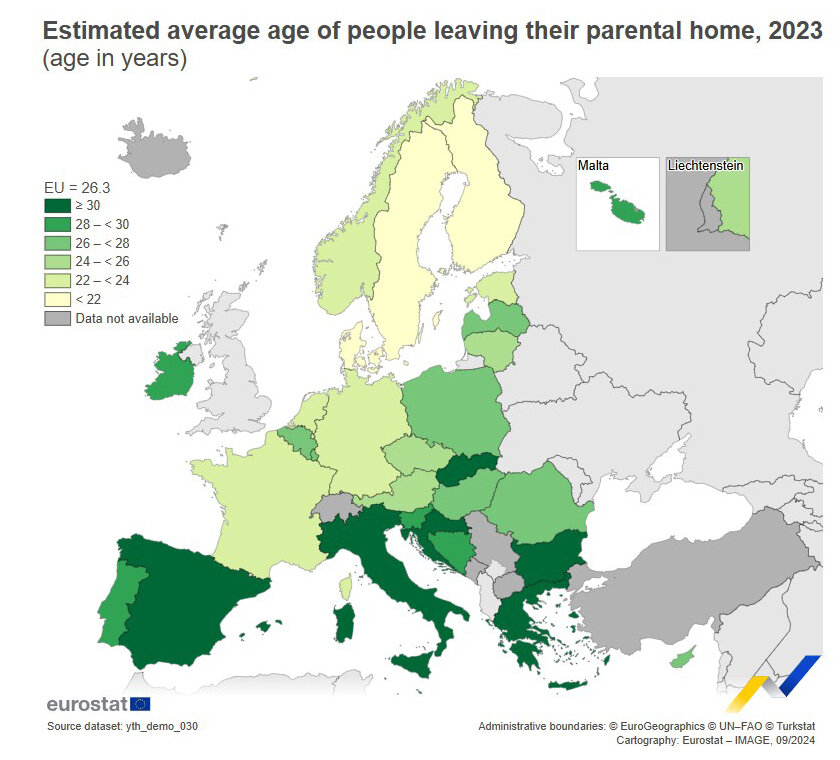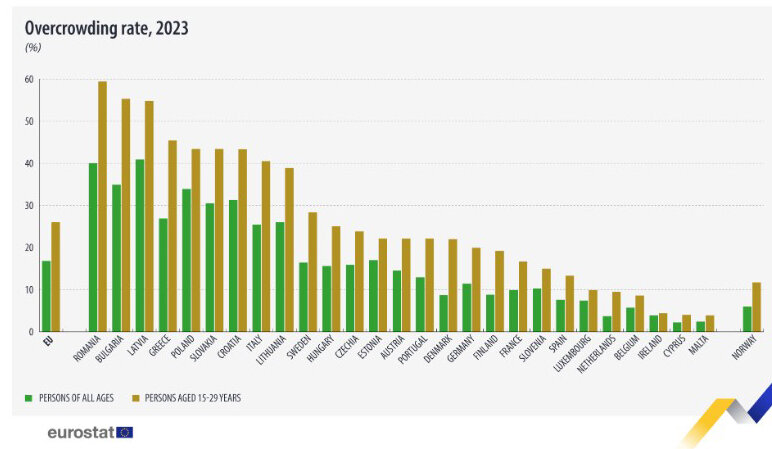читайте также
 Trump Tower to Be Built in Belgrade as Authorities Prioritize the Controversial Project
Trump Tower to Be Built in Belgrade as Authorities Prioritize the Controversial Project
 Rental rates for housing in Warsaw have reached a record level
Rental rates for housing in Warsaw have reached a record level
 Where the Wealthy Live Comfortably: The Latest Ranking of Cities and Countries
Where the Wealthy Live Comfortably: The Latest Ranking of Cities and Countries
 Emergency landings in Portugal: rising incidents raise questions about flight safety
Emergency landings in Portugal: rising incidents raise questions about flight safety
 Prime London Property Prices Fall 3.2%
Prime London Property Prices Fall 3.2%
 How EU countries issue Schengen visas to Russians after the new restrictions
How EU countries issue Schengen visas to Russians after the new restrictions
Young People in Europe Leave Their Parents' Homes at an Average Age of 26

According to Eurostat data, in 2023, young people across the European Union left their parental homes at an average age of 26.3 years. This figure was nearly the same in 2022 (26.4 years).
This study is particularly relevant to investors, as first-time housing for this demographic is typically rental property, influencing the rental market and prices.
Countries Where Young People Leave Home the Latest (30+ years)
- Croatia – 31.8 years
- Slovakia – 31.0 years
- Greece – 30.6 years
- Spain – 30.4 years
- Bulgaria & Italy – 30.0 years
Countries Where Young People Leave Home the Earliest (Under 23 years)
- Finland – 21.4 years
- Sweden & Denmark – 21.8 years
- Estonia – 22.8 years

Overcrowding Among Young People in the EU
In 2023, 26% of young people (ages 15-29) in the EU lived in overcrowded households. This is 9.2 percentage points higher than the overall population’s overcrowding rate (16.8%).

To illustrate the differences across Europe, Visual Capitalist published a ranking of countries based on the average age people move out.

Meanwhile, Statista provided data for Central and Eastern Europe. For instance, in 2023, young Croatians moved out at nearly 32 years old, whereas Estonians left home at 23.
Why Do Young People Move Out at Different Ages?
Experts highlight that the age of moving out depends on:
- Cultural norms
- Economic conditions
- The real estate market in each country
Since young adults usually rent their first home, rental demand is highest in countries where people leave home earlier. This factor is important for real estate investors. Additionally, homeownership traditions vary by country, affecting real estate prices and rental markets.
Homeownership Rates Across Europe (2023)
Statista's research division analyzed homeownership rates, showing that in countries with strong rental markets (e.g., France, Germany, UK, Switzerland), the percentage of homeowners is lower, and prices tend to be higher.
Top 10 European Countries with the Highest Homeownership Rates (2023)
- Albania – 95.9%
- Romania – 95.6%
- Slovakia – 93.6%
- Serbia – 91.6%
- Croatia – 91.2%
- Montenegro – 91.0%
- Hungary – 90.5%
- Lithuania – 88.8%
- Poland – 87.3%
- Bulgaria – 86.1%
Other notable countries:
- North Macedonia – 85.8%
- Latvia – 82.8%
- Estonia – 80.7%
Norway, Portugal, Czech Republic, Spain, Slovenia, Italy, Malta – also high ownership rates
In contrast, some Western European countries had lower homeownership rates:
- Belgium – 71.9%
- Netherlands – 70.2%
- Cyprus – 68.8%
- Luxembourg – 67.8%
- United Kingdom – 65.2%
- Sweden, France, Denmark – slightly lower
Countries with the Lowest Homeownership Rates in Europe (2023)
- Turkey – 56.7%
- Austria – 54.3%
- Germany – 47.6%
- Switzerland – 42.3%
These statistics highlight significant contrasts between Southern/Eastern Europe (high homeownership) and Western/Northern Europe (stronger rental markets).





